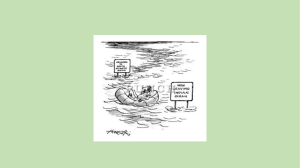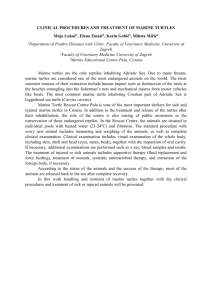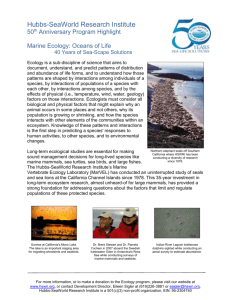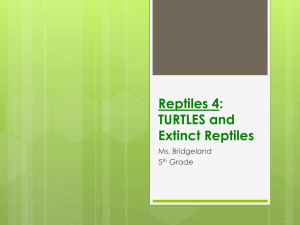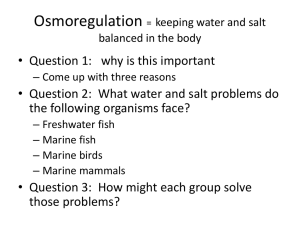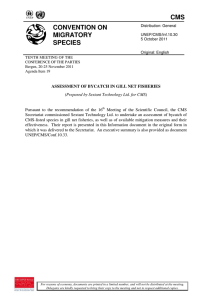Document 13036533
advertisement
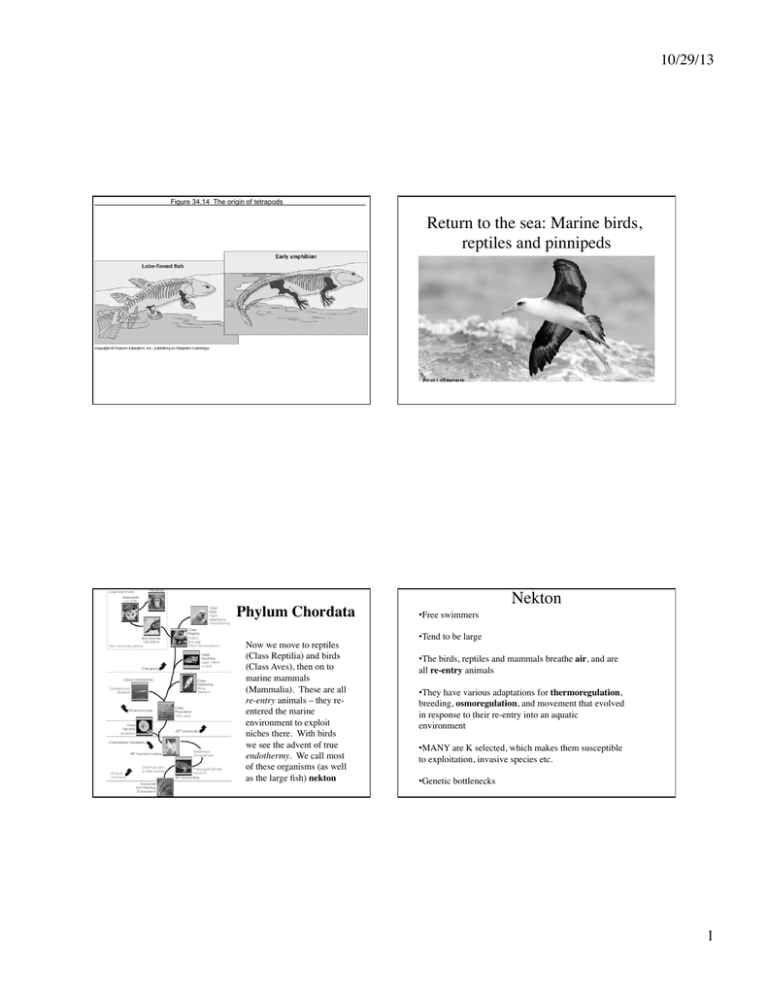
10/29/13 Figure 34.14 The origin of tetrapods Return to the sea: Marine birds, reptiles and pinnipeds Phylum Chordata Now we move to reptiles (Class Reptilia) and birds (Class Aves), then on to marine mammals (Mammalia). These are all re-entry animals – they reentered the marine environment to exploit niches there. With birds we see the advent of true endothermy. We call most of these organisms (as well as the large fish) nekton Nekton • Free swimmers • Tend to be large • The birds, reptiles and mammals breathe air, and are all re-entry animals • They have various adaptations for thermoregulation, breeding, osmoregulation, and movement that evolved in response to their re-entry into an aquatic environment • MANY are K selected, which makes them susceptible to exploitation, invasive species etc. • Genetic bottlenecks 1 10/29/13 Nekton adaptations Sea Turtles • r vrs. K selection reproductive strategies • Breeding on land – many still rely on land (but not cetaceans and some others) • Migrations – often long • Staying warm (endotherms) • Osmoregulation (salt and water balance) – Salt glands in marine birds remove excess salt from the blood LeatherBack 8 species, all threatened or endangered – all lay eggs on land and depend on beaches for reproduction Green Sea Turtle Strong Swimmers who spend most of their lives in the open water. Front flippers used for swimming, back flippers used for steering 2 10/29/13 Illness Sea Turtles Papilloma virus is affecting many sea turtles (especially greens). We don’t know why Take a look at the SWOT website: http://seaturtlestatus.org/ Sea Turtles Re-entered the sea about 150 MYA Have a very long generation time and life span (in excess of 80 years) Reproduce late (often not until they are 20-40 years old) K selected! They live throughout the tropics and suptropics Can stay underwater up to 50 minutes! They undertake extensive migrations from breeding to feeding areas Females have breeding site fidelity Sea Turtle diet Depends on the species…. Many juveniles are omnivorous (eat algae, plants and other animals) They are largely all carnivores and eat • Sponges - esp. Hawksbill turtles • Jellies and salps (leatherbacks) • Crabs • Fishes • Urchins • Gastropods • Cephalopods • Adult green turtles eat sea grasses and algae 3 10/29/13 Food Food Leatherbacks eat jellyfish and other soft-bodied animals. A floating plastic bag looks just like a jellyfish, but it will choke a sea turtle. Leatherbacks eat jellyfish and other soft-bodied animals. A floating plastic bag looks just like a jellyfish, but it will choke a sea turtle. Loggerheads heat hard shelled organisms. Nesting and breeding: Females nest every few years once reproductive They will return to the beach where they were born approx. every 2 weeks (up to 7 times) during the breeding season to lay up to 130 eggs Green Turtle nesting sites Males remain in the water – mating happens there Hatching happens after 9-10 weeks 4 10/29/13 Eggs Nesting The female leatherback comes ashore to nest. She crawls up at night, digs a hole in the sand, and lays 80 to 100 eggs. At dawn, she returns to the sea. Hatching The eggs hatch in about two months. Scientists can tell if the hatchlings will be male or female by the temperature of the nest. Colder temperatures produce males. Warmer temperatures produce females. 22.5-27 deg C = males, >30 def. C= females The eggs look like billiard balls. Their shells are soft and leathery. Scientists move nests that are too close to the water to safer areas or to hatcheries Hatching Hatchlings wait until night to leave the nest. Predators, like sea gulls, would eat them during the day. The new hatchlings head for the water. When they get there, they ride out to the sea. 5 10/29/13 Conservation Poaching – food and products CITES controlled – International treaties and some local regulations TED devices Light ordinances Protected beaches Controlled harvesting Plastics!! Habitat destriution: building on beaches Erosion and sea level rise Other Marine Reptiles Salt Water Crocodile Size: Where They Live: What They Eat: Special Facts: Other Marine Reptiles Sea Snakes Other Marine Reptiles Marine Iguana - Galapagos Special salt glands in the nose for salt excretion length of crocodile- 5 to 15 feet. coastal areas, tidal and nontidal near saltwater snails, frogs, fish turtles, snakes, waterfowl, small mammals the crocodile will swallow its prey whole. Crocodiles have been around since the dinosaurs 6 10/29/13 Seabirds Like the reptiles, pinnipends and cetaceans these are re-entry animals - they went from land back into the water. Why? • Sphenisciformes • Porcellariiformes • Charadriiformes • Anseriformes • Ciconiiformes • Pelicaniformes Something about…seabirds 28 orders of birds (8600 species) - 4 ‘true’ orders of seabirds Approx. 250 species • All seabirds still breed on land - many on islands • Many migrate long distances • Many are threatened or endangered • Many serve as harbingers of ocean conditions • Endotherms (higher body temperatures than us!) Adaptations • Webbed feet • Countercurrent heat exchangers • Oil in feathers (some) • Air in feathers (some) • Salt secreting glands • Variety of ‘lifestyles’ Seabird ‘lifestyles’ Seabird ‘lifestyles’ Shorebirds: ‘Waders’ Divers: ‘Pursuit divers’ • Long legs (some) • Webbed feet • Specialized bills • Low oxygen consumption • Countercurrent heat exchangers in legs • ‘Fusiform’ • Avocets, stilts, curlews, sanderlings, plovers • No oil in feathers 7 10/29/13 • Plunge divers • Skimmers and wanderers • Scavengers • Kleptoparasites! Counter current heat exchangers revisited • Blood in the arteries runs deep (not near the surface) • As it passes by cooler veins, it gives up some of its heat, warming up the veins. • In this way, heat can be ‘trapped’ within areas where it is needed Seabirds stay warm: • By using countercurrent heat exchangers • By having air in their feathers • Some have fat (penguins!) • Some have oil in feathers • High metabolism Seabirds osmoregulate: • By having a salt secreting gland (to get rid of excess salt) • By producing uric acid instead of urea (helps retain water) • By having efficient kidneys • They can drink seawater! Breeding on islands • Most seabirds breed on islands or in large colonies • What are the conservation implications? – Introduced rats, cats on islands where birds are ground nesters – Destruction of colony site = destruction of huge percentage of the population 8 10/29/13 Long migrations • Seabirds undertake some of the longest migrations of any animal: the arctic tern migrates 10,000 miles from the Arctic to the Antarctic! • These migrations are to and from feeding and breeding grounds. • Seabirds are highly dependent on oceanographic conditions and food availability 9
